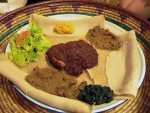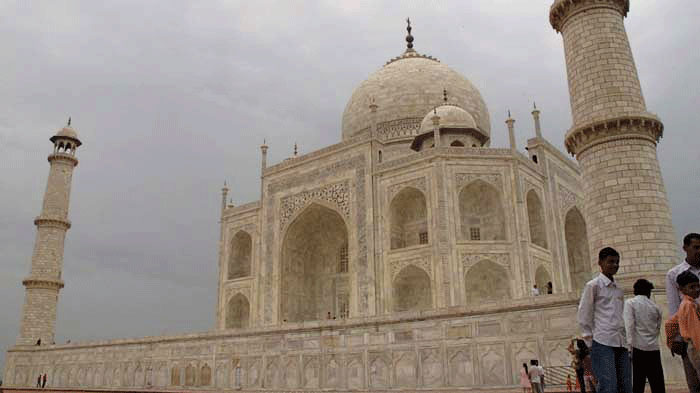
We often feel like we’re on a scavenger hunt when we travel for EYW. Sometimes we have just three days in a city to find all the foods we’ve researched, come up with good alternatives, entertain new ideas suggested by locals we meet, identify suitable “burn it off” locations. Despite the inevitable last-day dash around said city to tie up loose ends, we’ve become super efficient at these tasks. But doing it in, say, Boston and doing it in Agra, a garbage-strewn Indian city congested with all manner of human and animal traffic, are two very different things.
Last weekend, we arrived in Agra around 4:45pm after the 4.5-hour ride from Delhi, tired but hungry and eager to get started on our to-do list. We’d already encountered a few obstacles—the honking fiend of a driver arranged for us by Scott’s company couldn’t speak English and didn’t know his way around Agra at all. I’d assumed we’d use tuk-tuks to get around in town, but it didn’t make sense to pay a series of drivers when we were already paying for one for the weekend. One who came with some air-conditioned respite from the 105-degree heat. So despite being generally anti-guide, we had to hire one in Agra. As a bonus, he’d take us around the Taj Mahal in the morning. (That is, of course, why anyone ever comes to Agra in the first place.)
The guide, Danish, sat up front with our driver, Brijesh, and did a double take at the Google map I’d passed him. “Bhagat Halwai? You want to go to Bhagat Halwai?” he asked, incredulous. Indeed we did; I’d heard that was the best place for chaat around here. “Never in my six years of guiding has anyone asked to go there,” he told us. He turned to the task of directing Brijesh through the unruly streets of Agra. After a while we left the main highway for a dense interior lane that Danish introduced as a “short route.” We were promptly stuck behind a line of giant water buffalo.
The area, called Belanganj, was teeming with people on bikes, on foot, in tuk-tuks and bicycle rickshaws, on motorbikes and donkey-pulled wagons. Typical of what we’d seen of India thus far, the street was a free-for-all, traffic-wise: No unspoken “drive on the left” rule was in effect; swerving and plentiful honking were all but encouraged. One of the few dummies taking an automobile down this road, we might as well have had “wide load” plastered on our small sedan. We inched forward, past the rooftop monkeys and wandering goats and open-air food stalls, all the while doubting that any of our potential future readers would actually retrace these steps. (Dear readers: Take a tuk-tuk! With an English-speaking driver! It will be easier.)
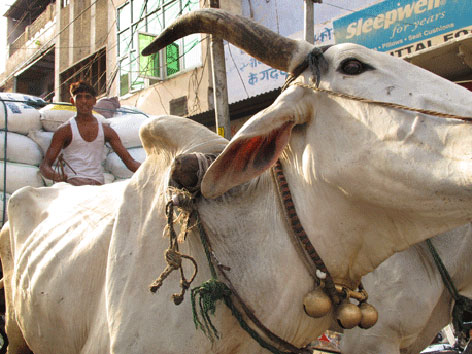
Finally, we hit the main M.G. Road and arrived at the chaat shop. We entered the air-conditioned confectioners half of Bhagat Halwai first, where our inquiries for chaat were met with totally blank faces and smiles. Danish to the rescue. The staff pointed us across the street, to the outdoor “food court.” So much for the cool air.
We scanned the menu and settled on bhalla, as the potato-and-chickpea patties were being freshly fried at that very moment. Rule no. 1 of street-eating in India: Make sure it’s fresh. Rule no. 2: Avoid raw unpeeled vegetables, of which this dish had none. What it did have was grated ginger and a spicy-sweet brown sauce that made us instantly happy and forgetful of the day’s headaches.
We had more to do, so settled on the one chaat (plus, the samosa guy was still forming the samosas, so no luck on that front). Back in the car, the discussion turned to parathas, North India’s beloved fried and usually stuffed breads. Agra has a famous vendor, Rambabu. Of course Danish knew it. But he said the original was back in “dangerous,” crowded Belanganj, and suggested we go to the branch near the Agra-Delhi highway, perhaps on our way home the next day. Nice try, Danish: We wanted the real-deal original. Back into the fray we went.
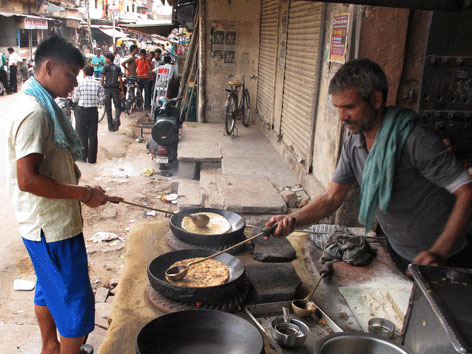
Rambabu’s parathas were greasy but good, and we assured our weary companions we had just one more quick stop—for Agra’s famed petha and dalmoth, both available from a sweets shop—before they were done for the night. Of course nothing is really “quick” in a city like this, so it was another hour-plus before we’d actually made it to the shop, attempted (unsuccessfully, for once) to haggle on prices, and walked out with two boxes of goods, to be photographed later. In truth, we were eager to cut them loose so we could go to Taj Ganj—the bustling area around the Taj Mahal, known for its rooftop hotels and restaurants, shops and touts—and get a beer and a quick glimpse of the Taj before the sun went down. We made it there, sans our crew, just before the sky went dark. Finally relaxing with Kingfishers and a sweet view, we decided to walk a bit, which is when we met a local jeweler named Arif. Arif sold me a pretty purple ring and gave us an enthusiastic recommendation for Mughlai food—the traditional cuisine of Agra, courtesy of the Islamic Mughal empire that ruled North India between the 16th and 19th centuries—the following day, for a restaurant I hadn’t encountered in my research. It sounded perfect.
Next day we had a late start (the driver overslept), but still arrived early enough to the Taj Mahal to beat the crowds and enjoy a semi-cool breeze. Danish got to exercise his passion for actual tourist-guiding between Agra’s two stunning Mughal monuments that morning: the Taj and the Agra Fort. In between, around 9am, we set off on another wild goose chase for the typical Agra breakfast: bedai and jalebi, a spicy potato-curry-and-fried bread affair followed up by a sugary, sticky-sweet dessert (the latter is pictured below). All for breakfast! It’s the kind of oddball, delicious pairing—sold on a busy street corner thronged by hungry locals—that makes me love this country.
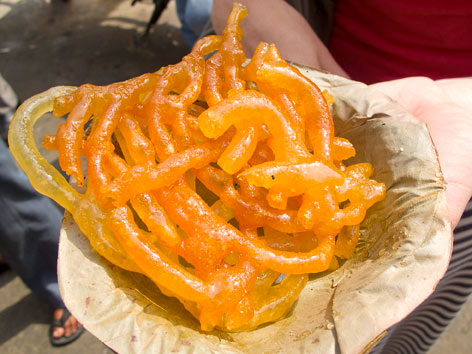
Everyone satiated, we piled back into the car and over to Agra Fort for a few more hours of sightseeing. We asked Danish if he enjoyed the “tour” he’d been giving us, and he said yes. “I don’t think I’ll ever guide anybody again like you two,” he told us. Probably safe to assume, yes.
When the heat became unbearable we left, bidding farewell to Danish only after he gave Brijesh explicit directions on where to drive next: Sadar Bazaar, home to several Mughlai restaurants, including the one Arif had suggested. We had one meal to go, a proper North Indian curry-and-bread kind of meal. We were back in the car to Delhi by 12:45pm, our bellies full and eyes wide at all we’d seen and done—and we were stuck in traffic.










.jpg)
